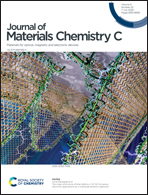From BiI3 to CuBiI4: a striking improvement in the photoelectric performance of a novel photodetector candidate†
Abstract
Bismuth halide based semiconductors have attracted increasing attention as the next generation photodetectors because of their excellent photoelectric performance, environmental friendliness, and high-element-abundance characteristics. However, it is still challenging to prepare a thin film under normal conditions because of the instability of BiI3. In this work, we use a room temperature elemental powder reaction in ambient conditions for the easy preparation of Cu incorporated perovskite-like CuBiI4 on a large scale. The crystalline and photoelectric characteristics of the resulting CuBiI4 thin films with different initial Cu content have been investigated by X-ray diffraction (XRD), UV-Vis spectroscopy, photoluminescence spectroscopy (PL), and transient surface photovoltage (TSPV) studies. The CuBiI4 based photodetectors were first assembled, which showed a striking improvement in the responsivity of the photodetectors compared with pure binary BiI3. Particularly, the responsivity of the photodetector with a 1 : 1 molar ratio of copper to bismuth is 106 times larger than that with an initial molar ratio of 0 : 1 (pure BiI3). A possible mechanism for such an improvement was preliminarily discussed by taking advantage of the Hall effect measurements. Our work not only provides a universal synthetic strategy for preparing high quality Bi-based perovskite-like photoelectric materials but also presents a novel Bi-based photodetector material.



 Please wait while we load your content...
Please wait while we load your content...